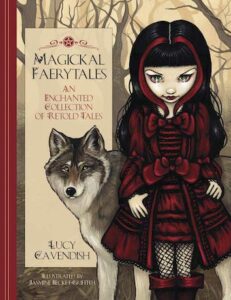 In 2019 I challenged myself to read a book a week – and hit 52. In 2020, I managed more than 70. I’m looking forward to trying to match that in 2021!
In 2019 I challenged myself to read a book a week – and hit 52. In 2020, I managed more than 70. I’m looking forward to trying to match that in 2021!
The Australian Fairy Tale Society’s March story was Hansel and Gretel (12 of 52), which was fun (and slightly disturbing!) to dive in to. One of my favourite variants is by Lucy Cavendish, from her beautiful hardcover book Magickal Faerytales: An Enchanted Collection of Retold Tales. Hansel and Gretel also have a card each in her gorgeous Faerytale Oracle created with Jasmine Becket-Griffith. Another favourite reimagining is from Susannah McFarlane’s wonderful Bold Tales For Brave-Hearted Boys, a companion to her brilliant Fairytales for Feisty Girls. I love the Hansel and Gretel artwork of Jan Pienkowski in his The Fairy Tales book too, which accompanies his Brothers Grimm story, and of course there was the Grimm story to re-read as well – plus the earlier variant Nennillo and Nennella by Giambattista Basile, in his collection The Tale of Tales, or Entertainment for Little Ones. It fascinates me how many faery tales share their plot DNA with others from all corners of the earth.
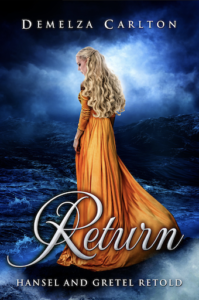 I love Australian author Demelza Carlton’s Romance a Medieval Fairytale series, which now has more than twenty titles, and her Hansel and Gretel reimagining, Return (13 of 52), is intriguing, magical, adventurous and fun – with some romance, and a little steam too. (Don’t worry, despite the witch thinking the two she’s trapped are brother and sister, Rhona and Grieve are most definitely not, it’s just a ruse to protect each other.) Return includes threads of the original faery tale, but weaves a whole new story, with a feisty heroine, an impending war, a girl with forbidden magic in her veins, and a boy who doesn’t think he’s worthy of her. With time running out, sisters to save, and invaders at their doorstep, can Rhona and Grieve save each other, and their home, or will family duty tear them apart?
I love Australian author Demelza Carlton’s Romance a Medieval Fairytale series, which now has more than twenty titles, and her Hansel and Gretel reimagining, Return (13 of 52), is intriguing, magical, adventurous and fun – with some romance, and a little steam too. (Don’t worry, despite the witch thinking the two she’s trapped are brother and sister, Rhona and Grieve are most definitely not, it’s just a ruse to protect each other.) Return includes threads of the original faery tale, but weaves a whole new story, with a feisty heroine, an impending war, a girl with forbidden magic in her veins, and a boy who doesn’t think he’s worthy of her. With time running out, sisters to save, and invaders at their doorstep, can Rhona and Grieve save each other, and their home, or will family duty tear them apart?
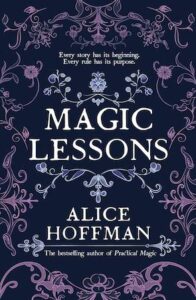 Bliss is a rainy Sunday on the couch with several pots of tea and a spellbinding book, and Alice Hoffman’s Magic Lessons (14 of 52) was perfect. The prequel to Practical Magic’s prequel The Rules of Magic, it traces the beginnings of the Owens family curse, when young Maria Owens escaped the seventeenth century witch trials of England only to land slap bang in the middle of Salem’s, via time practising her magic on a Caribbean island. Full of love and longing, hatred and revenge, wrong choices and true friends, religious persecution, fear and some favour, it’s an enchanting, gripping story that draws you deeply into Maria’s world and keeps you hooked til the final page. Now I’m eagerly awaiting the final book in the Owens saga, The Book of Magic, out in October this year…
Bliss is a rainy Sunday on the couch with several pots of tea and a spellbinding book, and Alice Hoffman’s Magic Lessons (14 of 52) was perfect. The prequel to Practical Magic’s prequel The Rules of Magic, it traces the beginnings of the Owens family curse, when young Maria Owens escaped the seventeenth century witch trials of England only to land slap bang in the middle of Salem’s, via time practising her magic on a Caribbean island. Full of love and longing, hatred and revenge, wrong choices and true friends, religious persecution, fear and some favour, it’s an enchanting, gripping story that draws you deeply into Maria’s world and keeps you hooked til the final page. Now I’m eagerly awaiting the final book in the Owens saga, The Book of Magic, out in October this year…
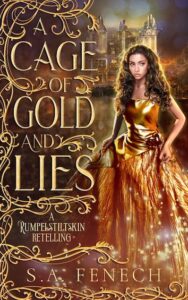 When I got stuck on the train for almost two hours thanks to torrential rain (just *five minutes* from Central, lol), I remembered I had the Magically Ever After collection on my phone, and started reading Selina A. Fenech’s amazing book A Cage Of Gold and Lies (15 of 52). And got totally sucked in, and had to stay up super-late to finish it. It’s a brilliantly reimagined version of Rumplestiltskin that weaves in new threads of magic, danger, heroism, sacrifice, puzzles, politics, love and war, with wonderful characters, a thrilling storyline, tiny clever nods to a few other faery tales, and incredible plotting. A totally enchanting novel. (Unfortunately the Magically Ever After collection – A Cage of Gold and Lies plus nine other full-length books – is now off sale, and Selina won’t release her book for at least a year because she has so many other awesome ones to get out first…
When I got stuck on the train for almost two hours thanks to torrential rain (just *five minutes* from Central, lol), I remembered I had the Magically Ever After collection on my phone, and started reading Selina A. Fenech’s amazing book A Cage Of Gold and Lies (15 of 52). And got totally sucked in, and had to stay up super-late to finish it. It’s a brilliantly reimagined version of Rumplestiltskin that weaves in new threads of magic, danger, heroism, sacrifice, puzzles, politics, love and war, with wonderful characters, a thrilling storyline, tiny clever nods to a few other faery tales, and incredible plotting. A totally enchanting novel. (Unfortunately the Magically Ever After collection – A Cage of Gold and Lies plus nine other full-length books – is now off sale, and Selina won’t release her book for at least a year because she has so many other awesome ones to get out first…
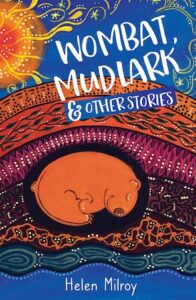 Wombat, Mudlark & Other Stories by WA author and illustrator Helen Milroy (16 of 52) is a gorgeous collection of timeless tales, of a wombat who helps mother earth, a dingo who saves the moon, a penguin who rescues a whale (and the sky) and many more. The beautifully evocative writing conjures images of our stunning country and its enchanting creatures, and the interconnected web we are all part of, and Helen’s gorgeous illustrations also add an extra layer of delight. The stories highlight the importance of friendship, courage, family, laughter, optimism, imagination, respect and wonder, and the fact that everyone has something important and unique to contribute to the world. Perfect as a bedtime story, or for independent readers from seven up, it’s a stunning book that highlights the magic of the earth and the landscape, and our adorable Aussie animals.
Wombat, Mudlark & Other Stories by WA author and illustrator Helen Milroy (16 of 52) is a gorgeous collection of timeless tales, of a wombat who helps mother earth, a dingo who saves the moon, a penguin who rescues a whale (and the sky) and many more. The beautifully evocative writing conjures images of our stunning country and its enchanting creatures, and the interconnected web we are all part of, and Helen’s gorgeous illustrations also add an extra layer of delight. The stories highlight the importance of friendship, courage, family, laughter, optimism, imagination, respect and wonder, and the fact that everyone has something important and unique to contribute to the world. Perfect as a bedtime story, or for independent readers from seven up, it’s a stunning book that highlights the magic of the earth and the landscape, and our adorable Aussie animals.
Helen is a descendant of the Palyku people of the Pilbara, and is a wonderfully talented artist and writer, as is her sister Sally Morgan. Helen was also Australia’s first Indigenous doctor, is Professor of Child and Adolescent Psychiatry at UWA, a Commissioner with the National Mental Health Commission, and was named WA’s Australian of the Year 2021. Wombat, Mudlark & Other Stories was short-listed for last year’s Readings Children’s Book prize, and is a gorgeous book that would make a wonderful gift for readers young and old. Her new series Tales From the Bush Mob is also brilliant – the first two are out now (I reviewed one in the new issue of Explorers magazine), with more to come!
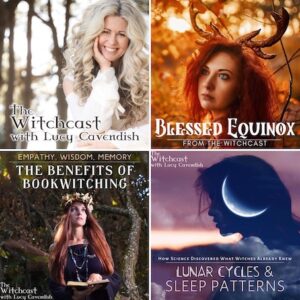 For the last few weeks I’ve been catching up on Lucy Cavendish’s Witchcast podcasts (17 of 52) instead of listening to audiobooks. Every episode is so packed full of magic, music, enchanting guests, book/movie goodness, health, joy and loads of info, I totally recommend it.
For the last few weeks I’ve been catching up on Lucy Cavendish’s Witchcast podcasts (17 of 52) instead of listening to audiobooks. Every episode is so packed full of magic, music, enchanting guests, book/movie goodness, health, joy and loads of info, I totally recommend it.
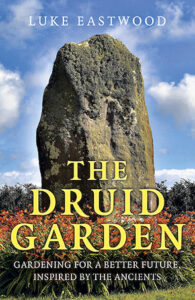 Combining the practical with the spiritual, horticulturist Luke Eastwood’s new book The Druid Garden (18 of 52) is a wonderful resource for anyone who loves gardening, nature, conservation, environmentalism, food sovereignty and/or follows an earth-honouring spiritual path. It begins with a lengthy section on the history of gardening, agriculture, herbal cultivation and medicine, permaculture (and its Australian roots), and how they’ve developed alongside human populations and cultures, entwined together. There are also sections on the importance of soil, the wonders of compost, the impact of location, dealing with pests and diseases, garden design, growing from seeds, cuttings and saplings, the benefits of companion planting and crop rotation, and much more.
Combining the practical with the spiritual, horticulturist Luke Eastwood’s new book The Druid Garden (18 of 52) is a wonderful resource for anyone who loves gardening, nature, conservation, environmentalism, food sovereignty and/or follows an earth-honouring spiritual path. It begins with a lengthy section on the history of gardening, agriculture, herbal cultivation and medicine, permaculture (and its Australian roots), and how they’ve developed alongside human populations and cultures, entwined together. There are also sections on the importance of soil, the wonders of compost, the impact of location, dealing with pests and diseases, garden design, growing from seeds, cuttings and saplings, the benefits of companion planting and crop rotation, and much more.
In addition to the practical elements of gardening though, Luke also focuses on spirituality, philosophy and environmentalism. Drawing on the spirit of druidry (while acknowledging there isn’t enough information about Celtic practices – in agriculture and gardening as well as ritual and religious custom – to create a literal druid garden), he outlines a way of gardening in harmony with the earth, as a sacred practise that realigns us with nature physically and emotionally, and will improve both our health and the planet’s.
Druidry is Celtic, and Luke was born in Scotland, grew up in rural England and has been living in Ireland for more than twenty years, so the book is definitely European-based. But I still found it fascinating, and relevant for down under nature lovers, and for everyone really, whether you have a tiny balcony garden or several acres to plant.
I especially love the lengthy sections on each individual plant, from trees and shrubs to herbs, fruits and vegetables. Close to a hundred of the almost 400 pages of the book are dedicated to trees, from alder, cherry and oak to juniper, rowan and willow, covering the legends of each one, its faery and pagan associations, medicinal and magical uses of the plant and all its parts, as well as how best to grow it wherever you live… Another hundred plus pages are devoted to shrubs and herbaceous plants, from blackberry, heather, ivy, lavender, olive and sage to the druidic herbs agrimony, comfrey, dandelion, foxglove, meadowsweet, mistletoe, nettle, self heal, thistle and yarrow, and there’s also a section on sacred food centring on fruit and vegies, food awareness, sustainability and self-sufficiency. Extensively researched while being based on even more lived experience, environmental activist Luke has created a wonderful reference book as well as a fascinating read, recommended for all of us who long to improve our health, connect with nature, make a difference to the planet, and tread lightly on the earth. Gardens are a blessing, providing not only food and medicine, but healing and solace too – something we’re all in desperate need of in these strange times.
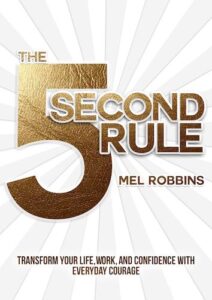 My final March read was The 5-Second Rule by Mel Robbins (19 of 52), which was awesome and inspiring. I got the audiobook on a whim, ages ago, when someone recommended it, then read some reviews, wasn’t sure I’d like it, and kind of forgot about it. But I finally started listening on my way home from the first day of Comic-Con, the night before I was speaking on stage for the first time, and I loved it. I’d already used the same principle – it’s how I got the courage to say yes to my first-ever panel 18 months ago (ie, read the invitation, type yes and hit send before I could second guess myself and say no) – but there’s something really powerful about the way Mel presents her experiences, research, the science, her conclusions and lots of testimonials. Yes, it is all stuff we kinda know already, but it’s so well presented, a brilliant confirmation and reminder, and a powerful butt-kick to actually put it into practise. Because although I’ve used it before, I can also point to several times I didn’t. Where I had an opportunity to do something I really wanted to do, or something I knew would be good for me, but I hesitated, my brain kicked in with all the reasons I shouldn’t do it, and the moment passed, leaving me filled with regret.
My final March read was The 5-Second Rule by Mel Robbins (19 of 52), which was awesome and inspiring. I got the audiobook on a whim, ages ago, when someone recommended it, then read some reviews, wasn’t sure I’d like it, and kind of forgot about it. But I finally started listening on my way home from the first day of Comic-Con, the night before I was speaking on stage for the first time, and I loved it. I’d already used the same principle – it’s how I got the courage to say yes to my first-ever panel 18 months ago (ie, read the invitation, type yes and hit send before I could second guess myself and say no) – but there’s something really powerful about the way Mel presents her experiences, research, the science, her conclusions and lots of testimonials. Yes, it is all stuff we kinda know already, but it’s so well presented, a brilliant confirmation and reminder, and a powerful butt-kick to actually put it into practise. Because although I’ve used it before, I can also point to several times I didn’t. Where I had an opportunity to do something I really wanted to do, or something I knew would be good for me, but I hesitated, my brain kicked in with all the reasons I shouldn’t do it, and the moment passed, leaving me filled with regret.
Some people have complained the book is repetitive and full of filler, and Mel concedes early on that it can be summed up in a sentence or two – but the how and why is fascinating and really reinforces things, and I’m really glad I read/listened to it all. By saying it in different ways, with different examples, with scientific back-up as well as real-life anecdotes – from people who used the rule to improve relationships, quit jobs, get promoted, improve their health and even not commit suicide – Mel really gets through, and makes a lasting impression. Simple, uncomplicated, practical, effective and powerful, and I absolutely recommend the audiobook. (And on that note, 5, 4, 3, 2, 1 – off to bed with me!)
* * *
FEBRUARY READS
Wow, February flew by, but I managed a book a week at least – and one of them (The Invisible Life of Addie LaRue) was MASSIVE!
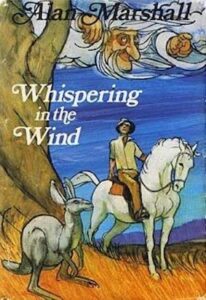 February’s story for the Australian Fairy Tale Society is Whispering In the Wind by Alan Marshall (8 of 52), the author of I Can Jump Puddles, which I vaguely remember reading at school (and which is an excellent argument for vaccinations, Alan suffering his whole life with polio, but that’s another story). Whispering In the Wind is a novel based on the quest of Peter, a kid from the bush who sets out to rescue a princess from a dragon. There’s a magical companion – talking kangaroo Greyfur, who knows the answer to every question and has a bottomless pouch she can pull an elephant, a crane and a wharfie from – a magic leaf, a magic horse, a sword-like whip, a witch who sweeps the moon every night (it was published in 1969, just after the first moon landing), a dragon who’s really a bunyip, giants and doubt cats and a castle where a princess is trapped (kind of odd, having a European castle in the middle of the Outback, but it’s nice to see the Australian landscape and its flora and fauna – if not, sadly, its First Nations people).
February’s story for the Australian Fairy Tale Society is Whispering In the Wind by Alan Marshall (8 of 52), the author of I Can Jump Puddles, which I vaguely remember reading at school (and which is an excellent argument for vaccinations, Alan suffering his whole life with polio, but that’s another story). Whispering In the Wind is a novel based on the quest of Peter, a kid from the bush who sets out to rescue a princess from a dragon. There’s a magical companion – talking kangaroo Greyfur, who knows the answer to every question and has a bottomless pouch she can pull an elephant, a crane and a wharfie from – a magic leaf, a magic horse, a sword-like whip, a witch who sweeps the moon every night (it was published in 1969, just after the first moon landing), a dragon who’s really a bunyip, giants and doubt cats and a castle where a princess is trapped (kind of odd, having a European castle in the middle of the Outback, but it’s nice to see the Australian landscape and its flora and fauna – if not, sadly, its First Nations people).
As much bush yarn as faery tale, it features great illustrations by Jack Newnham, a message of kindness and courage, and a compelling plot. It’s marred somewhat by the attitudes of the day and too many too-convenient plot solutions, but it’s a fun read, and there are some clever aspects too, and I can’t wait to chat about it with our English AFTS member this month!
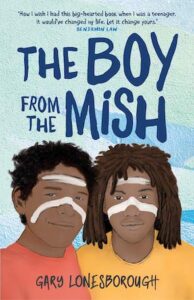 Boy From the Mish by Gary Lonesborough (9 of 52) is such a beautiful, emotive, important book, which will help so many people, and touch so many hearts. Set in a rural community on the south coast of NSW, it’s centred on seventeen-year-old Jackson, who is struggling to discover and allow who he is while also navigating the usual teen pressures of friendships, family issues, school challenges, bullies and racists. It’s about first love, self-love, cultural identity, dark secrets, and finding the courage to let the light in and be your true self. This tender love story is sweet and funny and brave and heart-warming. It’s raw and unflinching and occasionally heartbreaking. And it will stay with you long after you finish it.
Boy From the Mish by Gary Lonesborough (9 of 52) is such a beautiful, emotive, important book, which will help so many people, and touch so many hearts. Set in a rural community on the south coast of NSW, it’s centred on seventeen-year-old Jackson, who is struggling to discover and allow who he is while also navigating the usual teen pressures of friendships, family issues, school challenges, bullies and racists. It’s about first love, self-love, cultural identity, dark secrets, and finding the courage to let the light in and be your true self. This tender love story is sweet and funny and brave and heart-warming. It’s raw and unflinching and occasionally heartbreaking. And it will stay with you long after you finish it.
Says Gary: “This is the branch of hope I wish I could extend to teen-me. He really needed a book about a queer Koori kid back then… I hope now that it will find other teens who might need a book like this in their lives, so they can know they are not alone.”
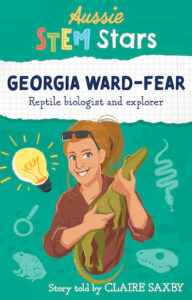 I love the awesome new Aussie STEM Stars series of books, which will inspire kids from eight to fifteen (core target 10-13)… It celebrates Australia’s leaders in Science, Technology, Engineering and Mathematics, with fun books that are written like novels but based on their true lives, covering what they were interested in as kids, what made them choose their career path, what their challenges and pitfalls were, and what drove them on to continue trying to change the world for the better. Each book is written by an award-winning children’s author and follows the real-life stories of some of Australia’s world-leading researchers and inventors, chosen for their contribution that is making a difference for humans and the planet. The first three books are out now, with more to come!
I love the awesome new Aussie STEM Stars series of books, which will inspire kids from eight to fifteen (core target 10-13)… It celebrates Australia’s leaders in Science, Technology, Engineering and Mathematics, with fun books that are written like novels but based on their true lives, covering what they were interested in as kids, what made them choose their career path, what their challenges and pitfalls were, and what drove them on to continue trying to change the world for the better. Each book is written by an award-winning children’s author and follows the real-life stories of some of Australia’s world-leading researchers and inventors, chosen for their contribution that is making a difference for humans and the planet. The first three books are out now, with more to come!
Georgia Ward-Fear’s book (10 of 52), written by Claire Saxby, is wonderful. Reptile biologist, conservation ecologist, wildlife warrior and STEM superstar Georgia fell in love with snakes and spiders as a kid, and loved exploring the bush near her home. This novel based on her life charts her passion for animals, her love of creepy bat skeletons, her care for injured creatures and passionate defence of their right to their habitat, her career indecision and missteps, and the curiosity and love of learning and adventure that led to her eventual PhD, and forged her pioneering work saving goannas from cane toads, and other solutions to environmental problems. An inspiring and fun read.
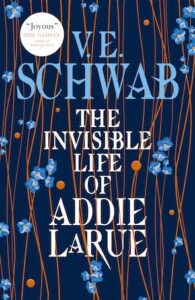 And I loved The Invisible Life of Addie LaRue by V. E. Schwab (11 of 52), the epic story of a young girl who makes a deal with an old god – one of the ones she was warned you should never pray to, one of those gods who answer after dark – and gets to live forever. The price she pays is that she is cursed to be forgotten. No one will ever remember her. Not her parents, not her best friend, not the woman she rented a room from half an hour before, who returns to turf her out into the darkness because she doesn’t recall her paying for it. Not the people who fall in love with her, who forget her by the time they wake from sleep the next morning and stare at her in embarrassment and suspicion. And no one, including her, can speak her name. It’s a fascinating premise, the power of a name, the power of a memory, the power of being forgotten.
And I loved The Invisible Life of Addie LaRue by V. E. Schwab (11 of 52), the epic story of a young girl who makes a deal with an old god – one of the ones she was warned you should never pray to, one of those gods who answer after dark – and gets to live forever. The price she pays is that she is cursed to be forgotten. No one will ever remember her. Not her parents, not her best friend, not the woman she rented a room from half an hour before, who returns to turf her out into the darkness because she doesn’t recall her paying for it. Not the people who fall in love with her, who forget her by the time they wake from sleep the next morning and stare at her in embarrassment and suspicion. And no one, including her, can speak her name. It’s a fascinating premise, the power of a name, the power of a memory, the power of being forgotten.
“You cursed me to be forgotten.”
“You asked for freedom. There is no greater freedom than that. You can move through the world unhindered. Untethered. Unbound.”
And along with the horror of her situation, there is the wonder of living for three centuries, of seeing inventions brought to life, watching wars rage and peace reign, witnessing the changes in attitudes to women (the main reason she made her desperate deal in the first place, to escape a life of drudgery and childbearing in a French village circa 1714, where death comes all too soon), learning countless languages and reading all the books you could dream of, meeting artists and writers and philosophers, and discovering tiny ways to leave your mark on a world that cannot remember you. For the same reasons I love Anne Rice’s vampire Lestat, I loved Addie’s contemplation and view of the passage of time, of history in the making, and of what it means to live forever – what you gain, but what you lose. How you cope, and what it transforms you into. Over the years she encounters her old god, the darkness, Luc, who she loves and hates, despises yet needs, the only person who can say her name. Until, after three hundred years, she meets a guy in a second-hand bookshop in New York who remembers her, and her existence is turned on its head.
It’s a beautifully written book, so evocative and enchanting, and the audiobook is gorgeously narrated by Julia Whelan, who perfectly evokes the moods and personalities of Adeline, Luc and Henry. It’s long (eighteen hours long), and occasionally a little longwinded, but I always wanted to know what would happen next, and figure out the mystery. Not everyone loved the jumping back and forth along the timeline, but I thought it worked really well. And not everyone was impressed by the ending, but I loved it!
* * *
JANUARY READS
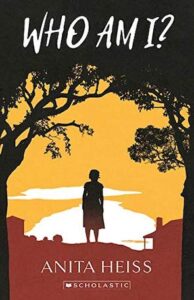 My first read for the year was Who Am I? by Anita Heiss, which is heartbreakingly sad, incredibly moving, yet ultimately filled with a little hope. Set in the 1930s, ten-year-old Mary Talance is a member of the Stolen Generations, like Anita’s grandmother, and so many others. The government policy of taking Aboriginal children from their parents then changing names and lying to everyone so they couldn’t find each other again is a horrifying, shameful and disturbing part of our history. It’s a terrible injustice, which still affects people today, and has been hidden away for far too long. Falsely justified for far too long. This book, and others, such as Archie Roach’s haunting memoir, are vitally important, so that we all know and understand what happened in the past, so it will never happen again. So we can try to understand the intergenerational trauma that still affects First Nations people.
My first read for the year was Who Am I? by Anita Heiss, which is heartbreakingly sad, incredibly moving, yet ultimately filled with a little hope. Set in the 1930s, ten-year-old Mary Talance is a member of the Stolen Generations, like Anita’s grandmother, and so many others. The government policy of taking Aboriginal children from their parents then changing names and lying to everyone so they couldn’t find each other again is a horrifying, shameful and disturbing part of our history. It’s a terrible injustice, which still affects people today, and has been hidden away for far too long. Falsely justified for far too long. This book, and others, such as Archie Roach’s haunting memoir, are vitally important, so that we all know and understand what happened in the past, so it will never happen again. So we can try to understand the intergenerational trauma that still affects First Nations people.
The diary format of this book is engaging and insightful, and having a young MC is perfect. There is so much wisdom and innocence in Mary’s genuine confusion at what has happened to her. At the terrible, confusing situations that make no sense at all. Why has her name been changed again? Why doesn’t her mother love her any more? Why is the school bully so cruel to her, just because of the colour of her skin? And beneath it all, who is she? I wish this was required reading for everyone, from politicians and law makers to school students and the rest of the population. There’s also a beautiful TED talk by author Anita Heiss here.
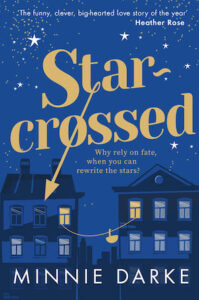 My second book of 2021 was Star-Crossed by Minnie Darke, a sweet, smart, funny story of love, friendship, scepticism, trust, and the intersection between them all. I loved endearing MC Justine, a hardworking and dedicated aspiring journo who embraces her flaws – although I did scream “No no no, please don’t do it!” once or twice. She’s a vintage-clothes-loving stealth grammar cop and an astrology sceptic, so when she runs into her first love, who’s returned to Melbourne and lives his life by the horoscopes in the magazine she works for, she figures a little tweaking of his stars won’t hurt. She’s only encouraging him to follow his heart and his dreams, right? Supporting him in a way his girlfriend does not? But Nick isn’t the only one who lives his life by this astrologer’s predictions, and sprinkled throughout the book are lots of vignettes of the other people impacted by Justine’s edits, some happy, some sad, some hilarious, all touching. There’s a slight nod to Love, Actually in the magical way the lives of all these strangers weave together by the end, and while Justine and Nick are at the heart of it, the many other characters are all vividly brought to life so you care about them too.
My second book of 2021 was Star-Crossed by Minnie Darke, a sweet, smart, funny story of love, friendship, scepticism, trust, and the intersection between them all. I loved endearing MC Justine, a hardworking and dedicated aspiring journo who embraces her flaws – although I did scream “No no no, please don’t do it!” once or twice. She’s a vintage-clothes-loving stealth grammar cop and an astrology sceptic, so when she runs into her first love, who’s returned to Melbourne and lives his life by the horoscopes in the magazine she works for, she figures a little tweaking of his stars won’t hurt. She’s only encouraging him to follow his heart and his dreams, right? Supporting him in a way his girlfriend does not? But Nick isn’t the only one who lives his life by this astrologer’s predictions, and sprinkled throughout the book are lots of vignettes of the other people impacted by Justine’s edits, some happy, some sad, some hilarious, all touching. There’s a slight nod to Love, Actually in the magical way the lives of all these strangers weave together by the end, and while Justine and Nick are at the heart of it, the many other characters are all vividly brought to life so you care about them too.
The audiobook is wonderfully narrated by Australian actor Arianwen Parkes-Lockwood, and it’s a beautifully written book (Minnie is a pen name of literary novelist Danielle Wood, whose books I’ll check out at some point). Moving, clever and witty, it’s a charming read about love, chance, destiny, and the choices we make, or refuse to.
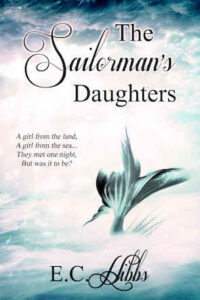 January’s faery tale is The Little Mermaid, so I’ve been diving in to a few mer-tales. I loved The Sailorman’s Daughters by E. C. Hibbs (3 of 52), where myth and magic blend with the real world, and a lonely young girl in a small Cornish fishing village discovers that some legends are true, and friendship can bloom in the strangest of circumstances… For #grababook, the third line on page 21: “Florence hadn’t been lying or spouting nonsense after all! There were mermaids!” I also love the tagline: A girl from the land, A girl from the sea… They met one night, but was it to be? And I loved Emma’s book Blindsighted Wanderer too…
January’s faery tale is The Little Mermaid, so I’ve been diving in to a few mer-tales. I loved The Sailorman’s Daughters by E. C. Hibbs (3 of 52), where myth and magic blend with the real world, and a lonely young girl in a small Cornish fishing village discovers that some legends are true, and friendship can bloom in the strangest of circumstances… For #grababook, the third line on page 21: “Florence hadn’t been lying or spouting nonsense after all! There were mermaids!” I also love the tagline: A girl from the land, A girl from the sea… They met one night, but was it to be? And I loved Emma’s book Blindsighted Wanderer too…
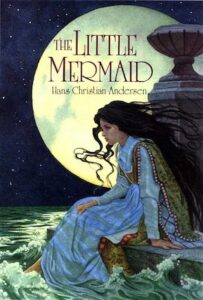 This month’s Australian Fairy Tale Society story is The Little Mermaid by Danish writer Hans Christian Andersen (4 of 52), a literary faery tale first published in 1837 – and I’d forgotten how depressing it is! Not just with the cutting out her tongue and each step being like dancing on knives (which is bad enough!), but the Prince making her sleep on the floor outside his door like a dog, and regaling her with tales of why he can’t love her. Not to mention her giving up her voice, her tail, her family, her 300 years, her *life*, for a guy she’d glimpsed a few times and could never speak to! But this book pretty much created the modern mermaid story, and has inspired hundreds since, and Charles Santore’s illustrations in this edition are so so beautiful.
This month’s Australian Fairy Tale Society story is The Little Mermaid by Danish writer Hans Christian Andersen (4 of 52), a literary faery tale first published in 1837 – and I’d forgotten how depressing it is! Not just with the cutting out her tongue and each step being like dancing on knives (which is bad enough!), but the Prince making her sleep on the floor outside his door like a dog, and regaling her with tales of why he can’t love her. Not to mention her giving up her voice, her tail, her family, her 300 years, her *life*, for a guy she’d glimpsed a few times and could never speak to! But this book pretty much created the modern mermaid story, and has inspired hundreds since, and Charles Santore’s illustrations in this edition are so so beautiful.
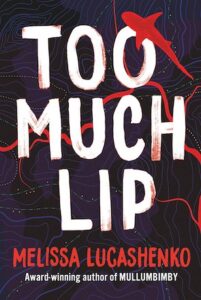 I really loved Too Much Lip by Melissa Lucashenko (5 of 52) – definitely a five-star read, and a worthy Miles Franklin Award winner. It’s harrowing and heartbreaking, although there are some moments of levity and joy amidst the violence and pain and suffering, and by the end, some redemption, forgiveness, and even a little hope. It’s not an easy read (or listen), but it shouldn’t be. Australia has a terrible history of invasion, colonisation and domination over the First Australians, which so many people (and politicians) still refuse to acknowledge, to our continuing shame. Trauma from past generations is still felt by so many First Nations people, and terrible injustices continue today. And while this book is fiction, every incident in it is based on fact, either from the author’s own family, or the historical record, which makes it even more moving, and devastating. But there’s no simplified “white people are all villains” or “Indigenous people are all faultless”. Each character is complex and multi-layered, and has done good and bad, sometimes for the right reasons, sometimes not. I don’t want to go into the plot too much, because I read a few reviews when I started it, and saw some unfortunate spoilers, but there’s family drama, a little crime, a big mystery, a legal case, a lot of perceptions challenged by all concerned, and a beautiful thread of connection to Country that gives the book its beating heart.
I really loved Too Much Lip by Melissa Lucashenko (5 of 52) – definitely a five-star read, and a worthy Miles Franklin Award winner. It’s harrowing and heartbreaking, although there are some moments of levity and joy amidst the violence and pain and suffering, and by the end, some redemption, forgiveness, and even a little hope. It’s not an easy read (or listen), but it shouldn’t be. Australia has a terrible history of invasion, colonisation and domination over the First Australians, which so many people (and politicians) still refuse to acknowledge, to our continuing shame. Trauma from past generations is still felt by so many First Nations people, and terrible injustices continue today. And while this book is fiction, every incident in it is based on fact, either from the author’s own family, or the historical record, which makes it even more moving, and devastating. But there’s no simplified “white people are all villains” or “Indigenous people are all faultless”. Each character is complex and multi-layered, and has done good and bad, sometimes for the right reasons, sometimes not. I don’t want to go into the plot too much, because I read a few reviews when I started it, and saw some unfortunate spoilers, but there’s family drama, a little crime, a big mystery, a legal case, a lot of perceptions challenged by all concerned, and a beautiful thread of connection to Country that gives the book its beating heart.
It’s full of strength and beauty, and the things that separate as well as those that bind us all together. The deep connection to family and Country of many of the characters is incredibly moving, and stayed with me long after I finished. And it’s beautifully written, parts dark humour and restrained fury, part historical record and even a touch of magical realism, and it brings the Bundjalung Country of northern NSW vividly to life, both the land and the animals a big part of the story, and characters in their own right. Bundjalung words are scattered throughout too, which adds another layer, and the audiobook is beautifully narrated by Tamala Shelton, a Bundjalung-Lamalama woman who narrates with passion and warmth, and inhabits each character perfectly. This is a compelling story that all Australians should read – and people from other countries would love too.
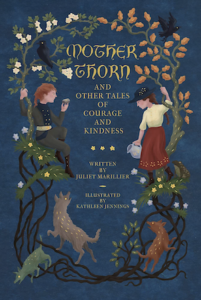 It’s always exciting when my favourite author releases a new book, and I adore Juliet Marillier’s latest release, Mother Thorn and Other Tales of Courage and Kindness (6 of 52), a wonderful collection of faery tales. The four short stories are beautifully written, filled with magic and wonder, kindness and courage, pots of tea, kitchen witchery and enchanted (and enchanting) creatures, and battles, soul mates, and beings from the Otherworld. Second chances, hard-won wisdom, and Juliet’s devotion and care for her much-loved rescue dogs are also woven throughout these charming stories. Three are inspired by existing faery tales – The Well of the World’s End, The Princess and the Pea, and The Tinder Box – but they are completely reimagined, and far more poignant and moving for it. The fourth is built around a snippet of folklore, and is just gorgeous. They all celebrate courage and kindness, and are about being true to yourself, discovering your inner strength, and recognising the good in others. It’s beautifully illustrated by Kathleen Jennings, and the stunning hardcover is available now from Serenity Press, and will be released more widely in April.
It’s always exciting when my favourite author releases a new book, and I adore Juliet Marillier’s latest release, Mother Thorn and Other Tales of Courage and Kindness (6 of 52), a wonderful collection of faery tales. The four short stories are beautifully written, filled with magic and wonder, kindness and courage, pots of tea, kitchen witchery and enchanted (and enchanting) creatures, and battles, soul mates, and beings from the Otherworld. Second chances, hard-won wisdom, and Juliet’s devotion and care for her much-loved rescue dogs are also woven throughout these charming stories. Three are inspired by existing faery tales – The Well of the World’s End, The Princess and the Pea, and The Tinder Box – but they are completely reimagined, and far more poignant and moving for it. The fourth is built around a snippet of folklore, and is just gorgeous. They all celebrate courage and kindness, and are about being true to yourself, discovering your inner strength, and recognising the good in others. It’s beautifully illustrated by Kathleen Jennings, and the stunning hardcover is available now from Serenity Press, and will be released more widely in April.
I counted all four of these as one book, so I’m not cheating on my book-a-week challenge!
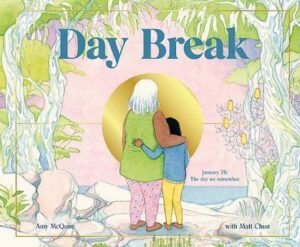 Day Break by Amy McQuire (7a of 52) is a beautiful and timely picture book for children – which will touch the hearts of adults too (I bought it for me J ). Australia has a brutal history of invasion, land theft, stolen children and genocide, and many First Nations people still suffer from intergenerational trauma and systemic racism, and the impact of more than two hundred years of violence, dispossession, and denial of their existence and their most basic rights. This is why an increasing number of people, Indigenous and non-Indigenous, don’t find Australia Day a time of celebration – to too many it is Invasion Day, Survival Day, a Day of Mourning… This gorgeous book has simplified the complexity of the ongoing debate with empathy, strength and hope, focusing on the connection of First Nations people to family, ancestors and Country. Beautifully illustrated by Matt Chun, it is a heartfelt, touching story that provides insight and understanding, and will hopefully encourage conversation as well as action. It’s time for #truthtelling.
Day Break by Amy McQuire (7a of 52) is a beautiful and timely picture book for children – which will touch the hearts of adults too (I bought it for me J ). Australia has a brutal history of invasion, land theft, stolen children and genocide, and many First Nations people still suffer from intergenerational trauma and systemic racism, and the impact of more than two hundred years of violence, dispossession, and denial of their existence and their most basic rights. This is why an increasing number of people, Indigenous and non-Indigenous, don’t find Australia Day a time of celebration – to too many it is Invasion Day, Survival Day, a Day of Mourning… This gorgeous book has simplified the complexity of the ongoing debate with empathy, strength and hope, focusing on the connection of First Nations people to family, ancestors and Country. Beautifully illustrated by Matt Chun, it is a heartfelt, touching story that provides insight and understanding, and will hopefully encourage conversation as well as action. It’s time for #truthtelling.
 With a Little Kelp from Our Friends: The Secret Life of Seaweed by Mathew Bate (7b of 52) is a gorgeous book, funny, fascinating, beautifully illustrated by Liz Rowland, and huge too – it’s a 35cm-tall, colourful hardcover you’ll want to treasure. It’s a celebration of the fact that scientists are discovering that seaweed is a climate-change superhero that will play a vital role in saving our precious planet. To many people this unassuming, sometimes-slimy algae is just a weed – but it can help stop global warming and remove carbon from the atmosphere, be eaten (it’s one of the most nutritious foods on the planet!), used as medicine, made into clothes, edible plastics and fuel for cars – and can even be fed to cattle to reduce their methane emissions, which is brilliant because each cow burps and farts around 300 litres of methane every day – one of the worst contributors to global warming. Filled with fascinating facts, activities, craft, tips, history, mythology, a seaweed guide, glossary and even a recipe, this book is a beautiful love letter to the unsung hero of the seas, and will inspire people to respect and protect the natural world, and appreciate just how seriously cool seaweed is!
With a Little Kelp from Our Friends: The Secret Life of Seaweed by Mathew Bate (7b of 52) is a gorgeous book, funny, fascinating, beautifully illustrated by Liz Rowland, and huge too – it’s a 35cm-tall, colourful hardcover you’ll want to treasure. It’s a celebration of the fact that scientists are discovering that seaweed is a climate-change superhero that will play a vital role in saving our precious planet. To many people this unassuming, sometimes-slimy algae is just a weed – but it can help stop global warming and remove carbon from the atmosphere, be eaten (it’s one of the most nutritious foods on the planet!), used as medicine, made into clothes, edible plastics and fuel for cars – and can even be fed to cattle to reduce their methane emissions, which is brilliant because each cow burps and farts around 300 litres of methane every day – one of the worst contributors to global warming. Filled with fascinating facts, activities, craft, tips, history, mythology, a seaweed guide, glossary and even a recipe, this book is a beautiful love letter to the unsung hero of the seas, and will inspire people to respect and protect the natural world, and appreciate just how seriously cool seaweed is!
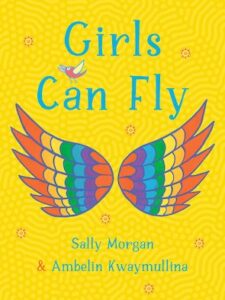 Girls Can Fly by Sally Morgan and Ambelin Kwaymullina (7c of 52) is an inspirational young teen book, from award-winning Aboriginal writer and artist Sally Morgan and her equally talented writer, artist and law academic daughter Ambelin. It’s vividly illustrated and full of wonderful advice, which combines to make a beautiful, thoughtful and encouraging book, and a perfect gift. Shout out too for Sally’s classic memoir My Place, in either the classic or younger reader versions, and Ambelin’s powerful verse novel Living On Stolen Land. And her novel The Interrogation of Ashala Wolf is on my tbr pile.
Girls Can Fly by Sally Morgan and Ambelin Kwaymullina (7c of 52) is an inspirational young teen book, from award-winning Aboriginal writer and artist Sally Morgan and her equally talented writer, artist and law academic daughter Ambelin. It’s vividly illustrated and full of wonderful advice, which combines to make a beautiful, thoughtful and encouraging book, and a perfect gift. Shout out too for Sally’s classic memoir My Place, in either the classic or younger reader versions, and Ambelin’s powerful verse novel Living On Stolen Land. And her novel The Interrogation of Ashala Wolf is on my tbr pile.
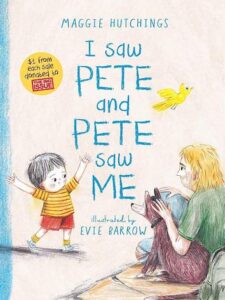 I Saw Pete and Pete Saw Me by Maggie Hutchings (7d of 52) is a beautiful, moving story told from a child’s perspective, about the complex issue of homelessness. While adults are often too busy to notice the people they walk past, children have the capacity to care, and to remind us of what is important. It’s beautifully illustrated by Evie Barrow, and sensitively written, and will hopefully open up conversations with young people, and with older ones too! There’s no easy solution, but this book provides hope and encourages empathy and kindness, and is a beautiful reminder of the capacity of children to understand more than they’re given credit for.
I Saw Pete and Pete Saw Me by Maggie Hutchings (7d of 52) is a beautiful, moving story told from a child’s perspective, about the complex issue of homelessness. While adults are often too busy to notice the people they walk past, children have the capacity to care, and to remind us of what is important. It’s beautifully illustrated by Evie Barrow, and sensitively written, and will hopefully open up conversations with young people, and with older ones too! There’s no easy solution, but this book provides hope and encourages empathy and kindness, and is a beautiful reminder of the capacity of children to understand more than they’re given credit for.
The author says: “The truth is hard-edged; there are no unicorn solutions for homelessness – but standing by and doing nothing isn’t an option. I am hopeful that by opening up conversations in homes, schools and communities, seeds of change will be sewn in small minds.”
A dollar from each sale is being donated to the wonderful The Big Issue, which provides work and income for homeless, marginalised and disadvantaged people. I also love Orange Sky Laundry, which offers a much-needed service for the homeless by providing free washing and shower facilities as well as conversation and caring.
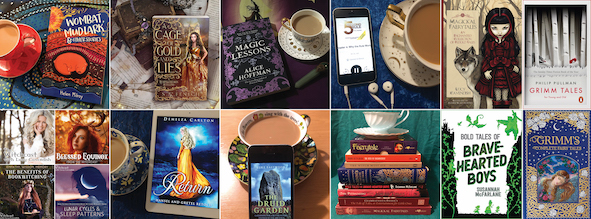


Get Social